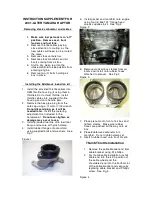
Start and driving
Description and operation
Hill Descent Control limits the speed on steep
descents by automatically braking all four
wheels, both when moving forward and in re-
verse. As the anti-lock brake system remains
active, it prevents the wheels from locking. In
vehicles with manual transmission, the Hill
Descent Control adapts the theoretical
speed without slowing the engine below its
idling speed.
After starting the descent of a slope below
30 km/h (18 mph), speed is limited to a mini-
mum of 2 km/h (1 mph) and a maximum of
30 km/h (18 mph). When appropriate, the
driver may increase or decrease the speed
within the limit by pressing the accelerator or
the brake. At this point the function is interrup-
ted and, if necessary, it is then reactivated.
Even so, it is imperative that the surface guar-
antees sufficient adhesion. For this reason,
the Hill Descent Control
will not
fulfil its func-
tion when, for example, descending a slope
with a frozen or slippery surface.
Hill Descent Control is available when the
dash panel display shows the message
.
Hill Descent Control automatically intervenes
if the following conditions are met:
●
The vehicle engine is running.
●
The
Offroad
driving profile has been selec-
ted
. Driving at a speed below
30 km/h (18 mph) (the message
is shown
on the instrument panel).
●
The slope of the descent is at least 10%
when driving forward and 9% when driving in
reverse.
●
The brake and the accelerator are not
pressed.
Hill Descent Control is deactivated on press-
ing the brake and the accelerator or if the
slope is below 5%. The function can be
switched off manually in the infotainment
system using the
> HDC
function button.
WARNING
Always be ready to brake. Otherwise, an
accident could occur and cause injury.
●
Hill Descent Control is only an auxiliary
system that in some situations may not suf-
ficiently brake the vehicle when going
down a slope.
●
The speed of the vehicle may increase
despite the intervention of Hill Descent
Control.
Steering
Information relating to different ve-
hicle processes.
Electro-mechanical power steering adapts
electronically
to the speed of the car, torque
and steering angle.
Even if the power steering fails or the engine
is stopped, it is possible to continue to rotate
the steering wheel as long as the key remains
in the ignition lock, but more force must be
applied.
Progressive steering
Depending on the vehicle’s features, it may or
may not incorporate a progressive steering
system.
In
city traffic
you do not need to turn so much
on parking, manoeuvring or in very tight turns.
On the
road
or on the
motorway
, progressive
steering transmits, for example, in bends, a
sportier, more direct and noticeably more dy-
namic driving sensation.
Steering assist
This help assists the driver in critical situa-
tions. It recommends turning the steering
wheel to perform a corrective manoeuvre
(counter-steering), turning slightly to avoid
skidding
.
»
229
Содержание Ateca 2020
Страница 1: ...Ateca Owner s manual 575012720BP Ingl s 575012720BP 07 20 SEAT Ateca Ingl s 07 20...
Страница 6: ......
Страница 70: ...Operation Fig 66 Instruments and controls 68...
Страница 357: ...Indications about the technical data Dimensions Fig 235 Dimensions 355...
Страница 374: ......
Страница 376: ...Ateca Owner s manual 575012720BP Ingl s 575012720BP 07 20 SEAT Ateca Ingl s 07 20...
















































